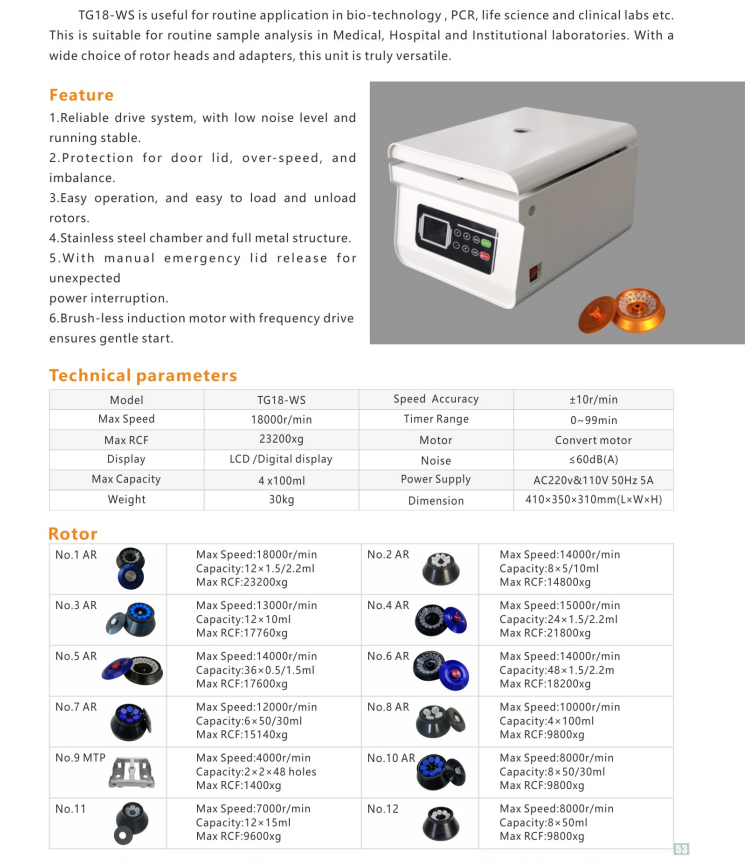
What is a High Speed Centrifuge and used for?
2024-07-20 10:19What is a High-Speed Centrifuge and used for?
A high-speed centrifuge is a laboratory instrument designed to spin samples at very high speeds, typically ranging from 10,000 to 30,000 revolutions per minute (RPM). These centrifuges generate high centrifugal forces, which are necessary for the rapid separation of various components in a sample based on their densities. High-speed centrifuges are essential in fields requiring efficient and effective separation of small particles or molecules, such as biochemistry, molecular biology, and clinical research.
Applications of High-Speed Centrifuges
High-speed centrifuges are used in various scientific and medical fields for a wide range of applications:
1. Molecular Biology and Biochemistry
Nucleic Acid Isolation:
High-speed centrifuges are used to isolate and purify DNA, RNA, and plasmid preparations from cell lysates. They facilitate the separation of nucleic acids from other cellular components efficiently.
Protein Purification:
These centrifuges help in the fractionation of cell lysates to isolate proteins. They are crucial in processes such as differential centrifugation, which separates proteins based on their size and density.
Virus and Organelle Isolation:
High-speed centrifuges are used to isolate viruses, subcellular organelles (such as mitochondria and nuclei), and other small particles from biological samples.
2. Clinical and Diagnostic Laboratories
Blood Component Separation:
In clinical settings, high-speed centrifuges are used to separate blood components, such as plasma, serum, and cellular fractions, for diagnostic purposes.
Cell Counting and Analysis:
They are used to concentrate cells from biological fluids for further analysis, such as in flow cytometry or cell counting procedures.
3. Industrial Applications
Pharmaceutical Development:
High-speed centrifuges play a role in the development and testing of pharmaceuticals by separating and purifying chemical compounds and biological samples.
Biotechnology:
In biotechnology industries, these centrifuges are used to purify biomolecules, such as enzymes, antibodies, and recombinant proteins, during product development and manufacturing.
Types of High-Speed Centrifuges
High-speed centrifuges come in various types, each designed to meet specific laboratory needs. The main types include:
1. Fixed-Angle Rotor Centrifuges
Description:
These centrifuges have rotors where the sample tubes are held at a fixed angle, usually between 25 and 45 degrees relative to the axis of rotation.
Advantages:
They are ideal for pelleting applications, such as collecting cell debris or precipitates, due to their efficient separation capabilities.
Applications:
Commonly used in cell biology for pelleting cells and organelles, and in molecular biology for nucleic acid precipitation.
2. Swinging-Bucket Rotor Centrifuges
Description:
In these centrifuges, the sample tubes are held in buckets that swing out horizontally during centrifugation, allowing the samples to experience uniform centrifugal force.
Advantages:
They are suitable for density gradient centrifugation, where samples need to be separated into distinct layers based on density.
Applications:
Frequently used in clinical laboratories for blood component separation and in molecular biology for gradient centrifugation.
3. Vertical Rotor Centrifuges
Description:
These centrifuges have rotors that hold the tubes vertically. They provide a short path length for particle sedimentation, resulting in faster separations.
Advantages:
They offer faster run times compared to fixed-angle rotors and are suitable for small-volume samples.
Applications:
Used for rapid nucleic acid or protein separations and for virus purification.
4. Continuous Flow Centrifuges
Description:
These centrifuges allow continuous introduction and separation of samples, making them ideal for large-scale separations.
Advantages:
They are efficient for processing large volumes of samples, reducing downtime and increasing throughput.
Applications:
Commonly used in industrial and bioprocessing applications, such as harvesting cell cultures and purifying large quantities of biological products.
Advantages of High-Speed Centrifuges
Efficiency:
High-speed centrifuges provide rapid separation of samples, significantly reducing processing times.
Versatility:
With a range of rotor options and adaptable configurations, high-speed centrifuges can handle various sample types and volumes.
High Throughput:
They allow for the simultaneous processing of multiple samples, increasing laboratory productivity.
Precision and Reproducibility:
The precise control of speed and time ensures consistent and reproducible results, critical for scientific research and clinical diagnostics.
Tips for Using High-Speed Centrifuges
Balance the Rotor:
Ensure samples are balanced symmetrically to prevent excessive vibration and damage to the centrifuge and samples.
Use Appropriate Tubes:
Select tubes that are compatible with the rotor and centrifuge specifications to avoid breakage or leakage during centrifugation.
Follow Manufacturer’s Guidelines:
Adhere to the recommended operating parameters and maintenance schedules to ensure optimal performance and longevity of the centrifuge.
Observe Safety Precautions:
Always use the centrifuge’s safety features, such as lid locks and imbalance detection, and never open the lid while the rotor is spinning.
Regular Maintenance:
Clean the centrifuge regularly and inspect rotors and tubes for any signs of wear or damage to ensure reliable operation.
